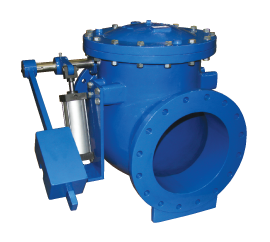Swing Check Valves Vs. Weight and Lever Check Valves
Within this article MGA Controls shares with PIF the different terminology used for a Check Valves, whether its a resilient hinge check valve or simply a swing check valve they are commonly used in pumping applications throughout the water and wastewater industry. They also compare the swing check valves to your typical Weight & Lever Check Valve.
Swing Check Valves, Resilient Hinge Check Valves and Weight and Lever check valves are commonly
Click here to find out the differences between Swing Check Valves and Resilient hinge check valves.
Are resilient hinge check valves superior to weight and lever valves, or do both have a place? This article explains the benefits of choosing a resilient hinge check valve over a weight and lever check valve in pumping applications.
Swing Check Valves (or Resilient hinge check valves) and Weight and Lever check valves are both types of ‘Non-return valves’. The primary purpose of a Non-Return Valve of any type is to protect the pump from damaging surge pressures following pump shut down in a pumping station.

Disadvantages of using conventional weight & Lever check valves in pumping applications
The traditional weight & lever Swing Check Valve has an 80-90° stroke from fully open to fully closed and requires an external Weight and Lever to speed up the closure of the Disc. Gravity is insufficient to close the valve fast enough, so a ‘weight’ is required to prevent reverse velocities building up and slamming the Disc into the valve Seat, causing damage to the Disc, Seat and surrounding pipework.
The Weight, Lever, Hinge and Disc assembly consists of a up to a dozen or so components which causes the snagging of rag in wastewater applications which can build up and prevent the disc from sealing or it can completely block up the valve.
Health & Safety regulations and WIMES dictate that the Weight and Lever must always be protected by a Guard - to prevent injury. However, the historical use of the lever to de-rag the valve, quickly back-flush the pump or use the lever to prove that the pump is in operation, means that the guard is often removed or on occasion never installed in the first place, due to the pressures of CAPEX.
Other issues are created as a result of the Weight, Lever & Hinge assembly:
- Firstly, the disc is pulled directly into the flow often allowing it to only open about half way in typical flow rates, needing approximately 2.5m/s to fully open. This restricts flow to sometimes less than half and increases head loss.
- Secondly, since the valves are often located in a confined space it is not possible to allow for the manufacturers specified number of straight diameter lengths before and after the valve to create linear flow. As a result the Disc, Weight & Lever move up and down in the flow and the oscillation of the hinge creates point wear. This results in leakage through the hinge, the hinge becoming disconnected from the disc or complete hinge collapse.
The Resilient Hinge Check Valve
The Resilient Hinge Check Valve was originally designed for clog free flow in the vertical.
The valve has a Steel and Nylon reinforced moulded disc & hinge assembly which relies on a guaranteed, repeatable elastomer as its spring and a 35° stroke to typically reduce closing speed by a 1/3.
Have you experienced these products within a water or wastewater application please leave PIF your comments.
Get the latest process industry news
Interested in receiving even more industry-leading news from Process Industry Forum delivered directly to your inbox? Then sign up to our free newsletter. Bringing you the latest news, trends, innovations and opinion from across the process industry, our exclusive newsletter gives you all the industry insights of the moment in one, easy-to-digest bulletin. Stay ahead of the competition with regular process industry news instalments from PIF.

